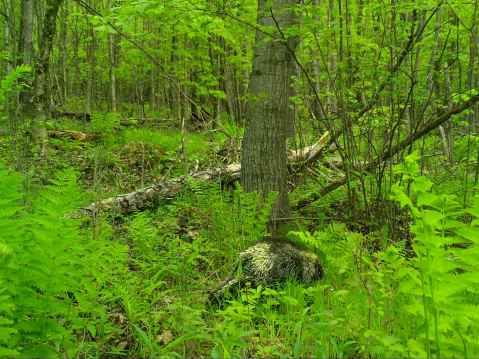Past Pieces: “Wisconsin’s prickly rodent”
The article below, “Wisconsin’s prickly rodent” by Alan D. Martin, was originally published in Wisconsin Natural Resources magazine in February 1996. We hope this article gives you a newfound enthusiasm for the “barbed quill-pig of the woods” as well!
The common porcupine (Erethizon dorsatum) is a wonderful, necessary member of Northwoods wildlife, and I’m glad it is here in large numbers. Throw stones if you want, but I’ll stand by porkies.
They kill trees, you say? Well, owls, wood ducks, hooded mergansers and woodpeckers need homes too, and porcupines are part of nature’s snag-making team.
Porcupines hurt my dog, you say? Well, most dogs learn from that first painful mistake and don’t go near porcupines again. Only one of my family’s six hunting dogs hasn’t gotten a snootful of quills in recent years, and only one needed a second dose to learn the lesson. The other grousers now bark, from a distance, at the quill-pig.
Because of such mishaps, some porcupines are shot on sight. That’s a real shame because the porky isn’t only the prickliest resident of the Northwoods, it’s also one of the most interesting.

Porcupine captured on a Vilas County Snapshot Wisconsin trail camera
Porkies are the second-largest rodent in Wisconsin after the North American beaver. They can weigh 30 pounds or more in summer but their weight drops dramatically during the lean months of winter. Porcupines live in the northern two-thirds of the state in a territory that extends in a V-shape from about the Ellsworth area in Pierce County down to Wisconsin Dells and back up toward Green Bay.
Porcupines, like most rodents, are vegetarians. Their winter diet consists of conifer needles, buds and the bark of pines, hemlock, maples and birch. How these critters survive on foods with a protein content of only two to three percent is truly amazing.
Porcupines are sloppy eaters who drop a lot of greenery that provides a welcome snack for white-tailed deer during deep snows. If you spot a small pile of freshly-snipped branches on a winter walk, it’s likely porcupines are nearby. Their winter dens are easy to find – just follow your eyes and nose. Porcupines winter in caves and hollow logs. They travel the same paths every day. Near their dens you’ll see distinctive fecal piles and smell the strong scent of concentrated urine.
In spring, abundant food allows the porcupines to roam more freely, and they grow fat and healthy while dozing in the dog days of summer. Porkies consume tender shoots, succulent twigs, roots, seeds and (often to the dismay of gardeners) apples, melons, carrots, potatoes and other juicy produce. Nor are the gardener’s tools immune to the porcupine’s gouging incisors. The animals need sodium to rid their bodies of high levels of potassium from leaves and bark. Axe handles, hoes, canoe paddles, gloves and anything else touched by salty human hands are porcupine magnets.
When defending itself, a porcupine sits very still, faces away from its enemy, raises up, bristles and rattles its quill-studded tail, protecting vital areas from potential predators with up to 30,000 barbed quills.

Porcupine captured on a Sawyer County Snapshot Wisconsin trail camera
Although porkies are slow, ambling creatures, it’s not always easy to keep your distance. A deer-hunting friend of mine still talks about his close encounter. Gary was sitting in his tree stand one day when a young-of-the-year porcupine climbed up the same tree and took a seat directly adjacent to Gary’s face. He was kind of cute (the baby porky, that is), as he sat there making little noises with his teeth and watching this newcomer to the tree. Somehow Gary didn’t find much to admire. He just kept a real close eye on the porky’s tail and slowly, calmly eased out of his stand and made his way down the tree. His heart was pounding pretty hard as he reached the ground and looked up at the porky still perched on a branch.
Only one predator poses a significant threat to porcupines – the fisher. These large weasels will wait for the right moment and inflict quick bites to the porcupine’s face and nose, areas that can take little abuse before the injury is fatal.
The porcupine is relatively silent throughout its life, so many people don’t recognize the whining squeal that sounds like a cross between a piglet and a crying baby. The sound varies in pitch and is most often heard in areas with rocky knobs and a good mix of conifers and hardwoods – prime porcupine habitat.
Native Americans had both respect and use for the porcupine. Its quills were incorporated in elaborate embroidered pieces, baskets and artwork. Porcupine quills were bartered and traded with plains tribes who had less frequent contact with the woodland creature.
So keep an eye out for the barbed quill-pig of the woods on your next winter walk. And if one finds you, show some respect.
To view the full posting of the article in the Wisconsin Natural Resources magazine, click this link.

